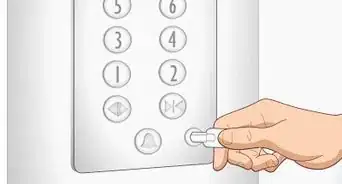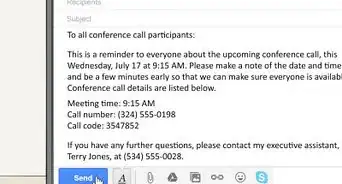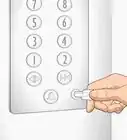This article was co-authored by Tami Claytor. Tami Claytor is an Etiquette Coach, Image Consultant, and the Owner of Always Appropriate Image and Etiquette Consulting in New York, New York. With over 20 years of experience, Tami specializes in teaching etiquette classes to individuals, students, companies, and community organizations. Tami has spent decades studying cultures through her extensive travels across five continents and has created cultural diversity workshops to promote social justice and cross-cultural awareness. She holds a BA in Economics with a concentration in International Relations from Clark University. Tami studied at the Ophelia DeVore School of Charm and the Fashion Institute of Technology, where she earned her Image Consultant Certification.
There are 8 references cited in this article, which can be found at the bottom of the page.
This article has been viewed 165,679 times.
The rules of riding in an elevator are unclear to many people. Are you supposed to hold the door? Should you speak to fellow passengers or not make eye contact? For some, riding in an elevator can be a stressful situation, due to claustrophobia, a fear of heights, and social anxiety. Whether you're at work, college, or living in a high-rise apartment, it never hurts to be courteous on an elevator. People take over 120 billion elevator rides per year, but some people still have no clue what the rules are. Here are some steps to ensure that you follow proper elevator etiquette so you and your fellow passengers can have a comfortable ride.
Steps
Practicing Good Elevator Etiquette When Boarding
-
1Stand to the side while you wait. While waiting for the elevator, stand away from the doors. Someone may be exiting at this floor, and you should always let them exit before you attempt to board.[1] Stand to the right of the doors so that the left and middle is open for those getting off the elevator. Don't board the elevator until everyone has gotten off.[2]
-
2Hold the door if it's not an inconvenience. There is a lot of debate about this particular point: do you hold the door or not hold the door? When deciding whether or not to hold the elevator, use the following suggestions to guide you:
- Don't hold the door if you are in an elevator full of people. You will be delaying everyone in the elevator and cramming one more person into a tight space.[3]
- If you are alone in the elevator, it’s good elevator etiquette to hold the elevator for a person approaching the elevator.[4]
- Don't hold the door for a friend or colleague who has taken a quick side-trip, such as to get coffee or go to the restroom. Never hold the door more than 15-20 seconds on a crowded elevator.
Advertisement -
3Don't try to squeeze onto a full elevator. When the elevator doors open and you see it is full, don't try to be that person that squeezes into the elevator when you don't fit. If you have been waiting in line and the elevator fills with the person before you, just wait patiently for the next. [5]
- Don't be the person asking for the elevator to be held. If you cannot make it before the elevator doors close, then wait for the next elevator politely instead of being rude. The people in the elevator's time is just as important as yours.
- During a pandemic like the COVID-19 outbreak, do not get onto an elevator with more than 3 people, and stand on opposite ends of the elevator.[6]
-
4Be the button pusher. If you are standing near the buttons, be willing to push a button for someone who asks. You can also ask someone who has just entered what floor they are going to.
- Don't ask someone else to push the button for you unless you cannot clearly push the button yourself.
-
5Move to the back. When you step into an elevator, file in so others can board behind you or board on another floor. Stay farthest from the door if you will be the last person to step out. If you are traveling to the ground or top most floor, it's better to stand farthest from the elevator doors after you board the elevator. This way you will avoid inconveniencing others.
- If you happen to be riding in the front, make sure to step off the elevator when the doors open on each floor. When in this position, hold the elevator with your hand as the people from the back of the elevator make their way out.
-
6Exit quickly. When you reach your floor, get out quickly so that those waiting to board can do so. Don't worry about letting other people off first unless they are already exiting. Simply exit in a quick and orderly fashion. However, do not shove your way out or knock people over in the process.
- If you're in the back, announce your floor is coming up as it approaches. A simple "Excuse me, my floor is next" is enough. Then, make your way to the front, or wait until the elevator stops.
-
7Consider taking the stairs. When only going one, two, or three floors, take the stairs instead of the elevator. Unless you are injured, unable to climb stairs, or carrying heavy objects, you shouldn't take the elevator for one floor. Taking the elevator for two or three floors, especially during busy elevator traffic, is also considered poor etiquette.[7] Reserve the elevator for people who have long walk ups or who are unable to climb the stairs.
-
8Respect lines. If the elevator is busy enough to have a line, never break in line. Wait your turn just like everyone else. If you are in a hurry, try to arrive earlier or take the stairs.
Practicing Good Elevator Etiquette When Riding
-
1Speak sparingly. One of biggest issues with elevator etiquette is whether or not someone should make small talk. Most people are hesitant to engage in conversation while in an elevator. However, it never hurts to offer a simple greeting, like "Good Morning" or "Hello," especially if you're boarding with your coworkers or neighbors.[8]
- If you are with someone, don't continue conversations while riding the elevator with someone else. Put the conversation on pause until you get to your destination.
- If you want to speak to a colleague in the elevator, keep the conversation light. Never gossip or discuss personal or private information while in an elevator.[9]
-
2Respect space. There is nothing more annoying than having someone stand six inches from you on an uncrowded elevator. If the elevator is crowded, give as much space as you can without crowding others or yourself. Follow these guidelines when standing on an elevator:
- If there are one or two other people on the elevator, go to separate sides of the elevator.
- If there are four people, go to each corner.
- If there are five or more, spread so each person is equally spaced in the elevator.
-
3Face forward. Making quick eye contact, smiling, and nodding is appropriate when entering an elevator. After that, turn around and face the door. Keeping your back towards the door and facing the passengers is a huge break in etiquette and can make some people feel extremely awkward.
-
4Hold all objects by your feet. When carrying briefcases, purses, backpacks, shopping bags, or other bulky materials, keep them low either directly in front of you or beside you. Legs take up less space than upper bodies, so there is more space for bags.
- If you are at the back of the elevator and carrying a bulky object, keep it low, announce your exit as the floor nears, and excuse yourself if you accidentally bump someone when exiting.[10]
-
5Never talk on your cell phone. A huge elevator faux pas is talking on your cell phone while riding. End all conversations before entering the elevator, or put the phone on mute until you exit again.[11]
-
6Don't move too much. Elevators contain a limited space, and in busy office buildings, many people try to fit into one car. Unnecessary movements can annoy fellow passengers, or cause you to make unwanted bodily contact. Jiggling your leg, pacing, moving your arms, or other movements can result in you rudely bumping into other passengers.
- Texting or looking at your phone is a common way to avoid eye contact with strangers. However, do not text in a crowded elevator. Operating your phone takes space, which is limited in an elevator, and the movement can cause you to bump people.
-
7Think about odors. Good hygiene should be practiced every day, but especially if you are taking elevators on a regular basis. The small, confined spaces can draw attention to any body odor. Try not to pass gas or belch while riding in the elevator. If you do, excuse yourself. Don't bring extremely smelly food onto the elevator. Instead, bring your food in containers. Never eat in an elevator. Never apply perfume or lotion. What smells normal to you may make someone else very sick.[12]
Expert Q&A
Did you know you can get expert answers for this article?
Unlock expert answers by supporting wikiHow
-
QuestionHow can you safely board an elevator during COVID?
 Tami ClaytorTami Claytor is an Etiquette Coach, Image Consultant, and the Owner of Always Appropriate Image and Etiquette Consulting in New York, New York. With over 20 years of experience, Tami specializes in teaching etiquette classes to individuals, students, companies, and community organizations. Tami has spent decades studying cultures through her extensive travels across five continents and has created cultural diversity workshops to promote social justice and cross-cultural awareness. She holds a BA in Economics with a concentration in International Relations from Clark University. Tami studied at the Ophelia DeVore School of Charm and the Fashion Institute of Technology, where she earned her Image Consultant Certification.
Tami ClaytorTami Claytor is an Etiquette Coach, Image Consultant, and the Owner of Always Appropriate Image and Etiquette Consulting in New York, New York. With over 20 years of experience, Tami specializes in teaching etiquette classes to individuals, students, companies, and community organizations. Tami has spent decades studying cultures through her extensive travels across five continents and has created cultural diversity workshops to promote social justice and cross-cultural awareness. She holds a BA in Economics with a concentration in International Relations from Clark University. Tami studied at the Ophelia DeVore School of Charm and the Fashion Institute of Technology, where she earned her Image Consultant Certification.
Etiquette Coach
-
QuestionShould a man step aside to allow women to exit the elevator first?
 Community AnswerIf one feels chivalrous, yes, but don't feel offended if a male co-worker doesn't. We all have places to be.
Community AnswerIf one feels chivalrous, yes, but don't feel offended if a male co-worker doesn't. We all have places to be. -
QuestionWhat is the etiquette when waiting for the elevator and people are exiting? Is it proper to wait for those to exit before entering?
 Community AnswerYes. Stand to the right of the doors so everyone can exit. Once the elevator is empty, then you may board.
Community AnswerYes. Stand to the right of the doors so everyone can exit. Once the elevator is empty, then you may board.
References
- ↑ Tami Claytor. Etiquette Coach. Expert Interview. 29 September 2020.
- ↑ http://www.mannersmentor.com/only-at-work/elevator-etiquette-the-dos-and-donts-of-riding-with-others-you-want-to-know
- ↑ http://www.esquire.com/blogs/news/huddled-masses-elevator-etiquette
- ↑ Tami Claytor. Etiquette Coach. Expert Interview. 29 September 2020.
- ↑ http://www.telegraph.co.uk/men/thinking-man/10428737/Man-Manners-the-art-of-elevator-etiquette.html
- ↑ Tami Claytor. Etiquette Coach. Expert Interview. 29 September 2020.
- ↑ http://gothamist.com/2013/08/21/the_most_important_elevator_etiquet.php
- ↑ Tami Claytor. Etiquette Coach. Expert Interview. 29 September 2020.
- ↑ http://www.coca-colacompany.com/stories/elevator-behavior-the-good-the-bad-and-the-bizarre
- ↑ http://www.mannersmentor.com/only-at-work/elevator-etiquette-the-dos-and-donts-of-riding-with-others-you-want-to-know
- ↑ http://www.goodhousekeeping.com/family/etiquette/elevator-etiquette-peggy-feb05
- ↑ http://www.townandcountrymag.com/leisure/arts-and-culture/news/a2490/all-aboard-elevator-etiquette-to-keep-in-mind/
About This Article
Practicing good elevator etiquette is all about respecting the needs of the other passengers you're riding with. Wait to the right of the door so you’re not in the way of people coming out. Once it arrives, let people out before you try to get in. Move to the back of the elevator if you’re traveling several floors so you don’t get in the way. It’s generally considered bad etiquette to start up a conversation, but you can say “Good morning” or something similar. If you’re standing near the buttons, offer to press the floor someone wants when they get on. You should hold the elevator for someone approaching the doors if there’s plenty of space inside. However, don’t do so if the elevator is full. For tips on how to use your cell phone in an elevator, keep reading!










































































